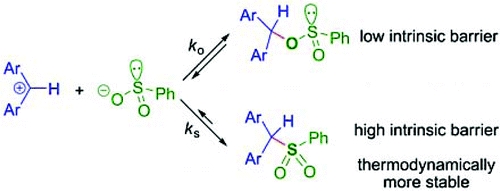Nucleophilicity and Nucleofugality of Phenylsulfinate (PhSO2−): A Key to Understanding its Ambident Reactivity
08-Apr-2010
J. Am. Chem. Soc., 2010, 132, 4796-4805 published on 12.03.2010
J. Am. Chem. Soc.
Second-order rate constants for the reactions of the phenylsulfinate ion PhSO2− with benzhydrylium ions Ar2CH+ have been determined in DMSO, acetonitrile, and aqueous acetonitrile solution using laser-flash and stopped-flow techniques. The rate constants follow the correlation equation log k (20 °C) = s(N + E), which allows the determination of the nucleophile-specific parameters N and s for PhSO2− in different solvents. Second-order rate constants for the reactions of the phenylsulfinate ion PhSO2− with benzhydrylium ions Ar2CH+ have been determined in DMSO, acetonitrile, and aqueous acetonitrile solution using laser-flash and stopped-flow techniques. The rate constants follow the correlation equation log k (20 °C) = s(N + E), which allows the determination of the nucleophile-specific parameters N and s for PhSO2− in different solvents. With N = 19.60, PhSO2− is a slightly weaker nucleophile than malonate and azide ions in DMSO. While PhSO2− reacts with highly stabilized benzhydrylium ions to give benzhydryl phenyl sulfones exclusively, highly reactive benzhydrylium ions give mixtures of sulfones Ar2CH−SO2Ph and sulfinates Ar2CH−OS(O)Ph; the latter rearrange to the thermodynamically more stable sulfones through an ionization recombination sequence. Sulfones generated from PhSO2− and stabilized amino-substituted benzhydrylium ions undergo heterolysis in aqueous acetonitrile and the rate of formation of the colored benzhydrylium ions was followed spectrophotometrically by stopped-flow techniques. The ranking of the electrofugalities of the benzhydrylium ions (i.e., the relative ionization rates of Ar2CH−SO2Ph) was not the inverse of the ranking of their electrophilicities (i.e., the relative reactivities of Ar2CH+ with nucleophiles), which was explained by differences in Marcus intrinsic barriers. While sulfones are thermodynamically more stable than the isomeric sulfinates, the intrinsic barriers for the attack of benzhydrylium ions at the oxygen of PhSO2− are significantly lower than the intrinsic barriers for S-attack, and the activation energies for the attack of carbocations at sulfur are only slightly smaller than those for attack at oxygen. Because reactions of PhSO2− with carbocations of an electrophilicity E > −2 (i.e., carbocations which are more reactive than Ph3C+) are diffusion-controlled, the regioselectivities of the reactions of PhSO2− with “ordinary” carbocations do not reflect relative activation energies.



